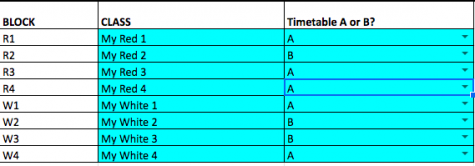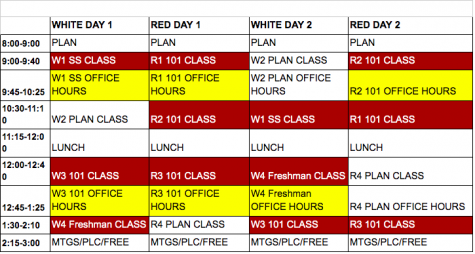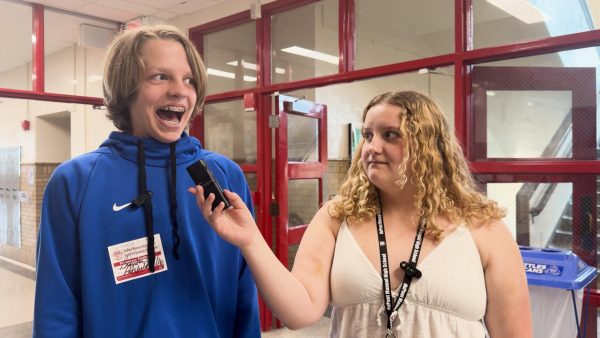Get ready for NTI 2.0
August 24, 2020
They’re calling it “NTI 2.0.”
As JCPS and Manual begin non-traditional instruction (NTI) on August 25th, students will notice several changes to the virtual instruction — described as “NTI 1.0” — offered last spring.
With NTI until at least September per Governor Andy Beshear’s recommendation, each JCPS school’s implementation plan varies. Manual faculty and administrators developed a system that offers some flexibility to both teachers and students.
Day-to-day schedule
Manual released an “NTI Portal” including features like a fill-in-your-own schedule document and links to each teacher’s plan for the first week of school.
Students need to visit the documents each of their teachers created to organize their schedule in the table provided.

The schedule will work on two timetables based on the decision of each teacher: timetable A will include a full, 90 minute class period once a week, while timetable B follows a 40 minute period schedule twice a week. If the teacher follows timetable B, the rest of the 90 minutes will be class office hours.
Here are examples of both timetable A and timetable B. While a student’s schedule is largely based on the discretion of the teacher, every student will meet with their teacher on a virtual meet either once or twice a week.


All students will have a lunch break from 11:15-noon and then resume their scheduled meetings.
Visit the NTI portal here to create your personalized schedule.
Grades
When Manual began NTI in the spring, grading was largely based on attendance and participation to accommodate to student’s unique circumstances in the midst of COVID-19.
Because NTI 2.0 will possibly go on longer than the initial six weeks, Manual will be switching to a grading system that emphasizes growth and progression rather than solely participation.
Principal Farmer and other administrators recommend teachers use “standard-based grading marks” instead of traditional, percentage-based ones.
Standard-based grading is on a scale of 1-4: 1 meaning below standards, 2 meaning approaching standards, 3 meaning the student is meeting standards and 4 meaning the student is above standards. Additionally, the use of zeros for missing grades is discouraged.
Grades can be converted back to the conventional, percentage-based grading system as a means of communicating feedback with the students, but all grades should ultimately follow the 1-4 scale.
The district and Manual administrators also recommend that teachers get rid of the engagement grading category entirely, weighting the progression and mastery categories at 50% each, in order to acknowledge that students’ circumstances and internet access may make real-time participation more difficult.
Flexibility is another key point to focus on when grading student’s work, according to the “Assessment and Grading Recommendations and Guidance” document Manual is using to guide their grading practices.
“Consider designing learning and assessment with much flexibility for learners to access, engage with, and demonstrate mastery of content and skills. While there is some attention to timeliness, readiness to show competency should be accommodated,” the document states.
The document also gives final tips and encouragement to teachers as they adjust to online learning and the new grading system.

Homework and workload
Workload will ultimately vary from teacher to teacher, but Manual administrators do not want teachers to overload students with work.
“We don’t want students sitting in front of their computers 7 hours a day,” Assistant Principal Klingenfus said in a phone interview with RedEye.
Students react
With the NTI 2.0 portal up and running, both students and parents are adjusting to the new schedule.
Dylan Fox (11, YPAS) was initially confused by the set-up but is putting her trust in the administration.
“I trust they [Manual] know what plan will be best,” Fox said. “I figure it will be easier to understand once school starts.”
Mikayla Huynh (12, HSU) was not satisfied with the original NTI in the spring but believes Manual is handling online school much better the second time around.
“I feel like it gives me the freedom to determine when I want to work on school and then gives me time to work on college stuff too,” Huynh said. “Everything is kind of evenly spaced out.”
As an incoming freshman, Lily Cashman (9, J&C) also agrees with the way Manual organized the schedule as she enters high school.
“The A/B schedule will allow teachers some flexibility on how to best run their class while also keeping structure to the students’ learning,” Cashman said. “With the longer lunch break and ‘day off’ on Wednesdays, it will help me stay focused and stress-free.
And while Juliet Bailey (10, HSU) recognizes the improvements Manual has made from the spring, she does not agree with the way Manual went about introducing NTI 2.0 to students.
“I am not impressed with the late timing that we received our schedule instructions because it left some of us feeling anxious about plans for the year and under-communicated with the staff,” Bailey said.
Additionally, Bailey does not feel that students building their own schedule is beneficial.
“The way the schedule visualizer was set up leaves a lot of room for error,” Bailey said. “Even though there was a video tutorial, typing one mistake would leave one’s entire schedule off course. It would be nice to be sent a definite schedule to confirm that the one we made is without error.”
However, Bailey understands that this situation is unprecedented for everyone involved.
“I do think Manual is trying its best to navigate through these circumstances,” Bailey said. “I am grateful for any opportunity to resume learning.”

















